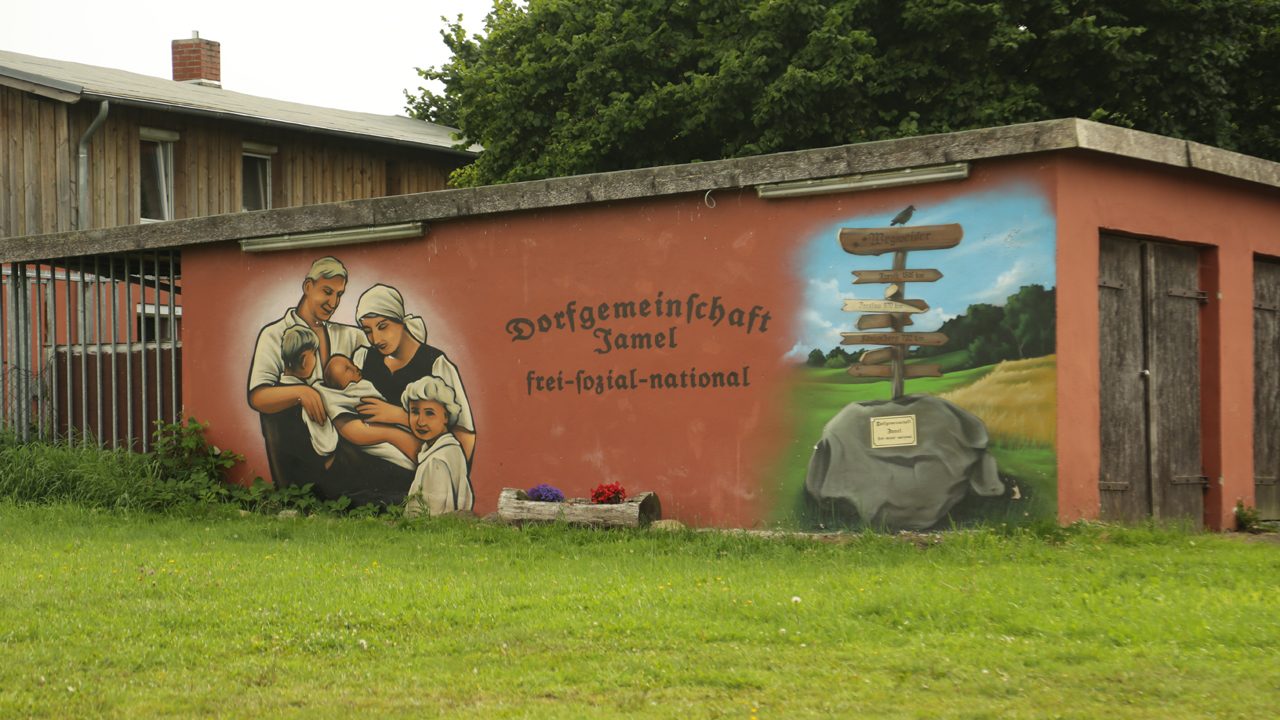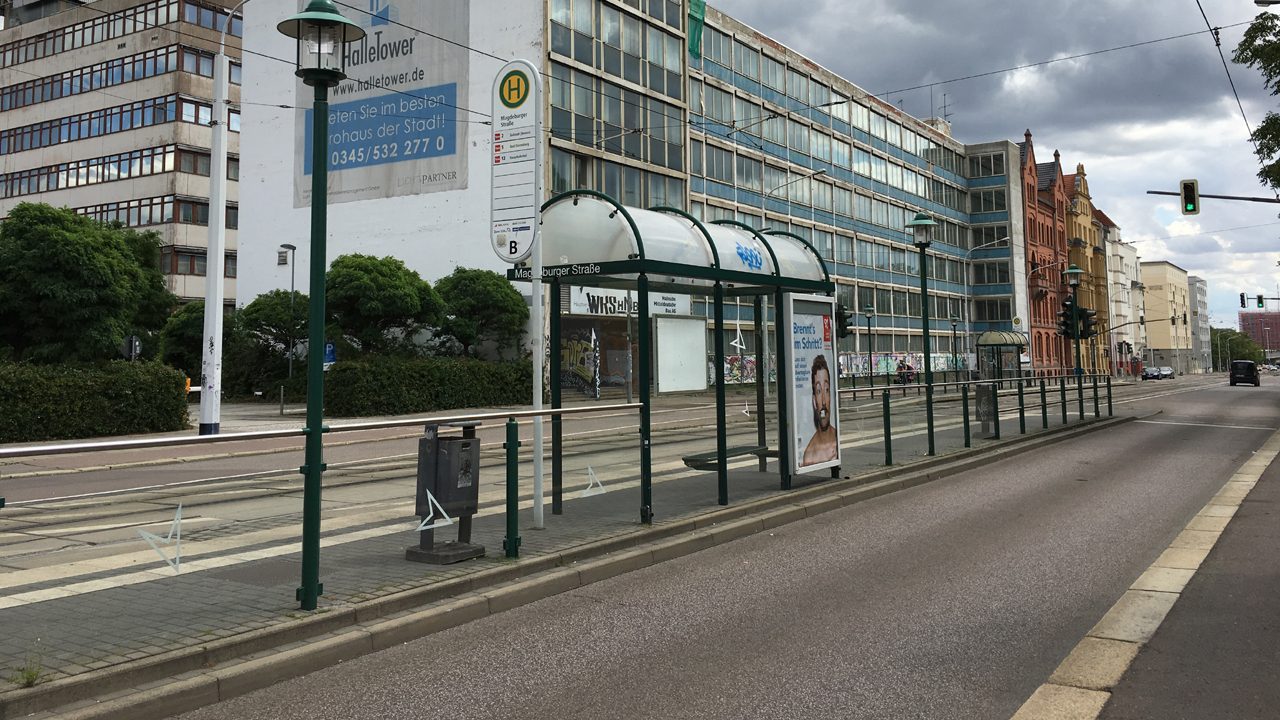
For years, the far right has been trying to gain a foothold in rural areas across Germany – with mixed results. Far away from urban “multiculturalism”, metropolitan diversity, but also societal pressure, right-wing extremists dream of far-right spaces where they can school, train, party, raise children and spout their hate undisturbed. Spaces in which Hitler salutes, banned symbols and blacklisted Nazi bands are the norm. Where they can let their dehumanising ideology run riot.
From pubs to martial arts studios, house projects to settlements, these spaces function as regional anchors for various far-right groups. They are strategic sites that enable further radicalisation as well as networking within the scene. But their infrastructure also has an economic function: concerts and festivals, tattoo studios and mail order companies, even record labels and publishing houses are a lucrative source of income for the scene. To top it off: these properties are also used for paramilitary exercises and the storage of weapons and explosives.
The real estate ambitions of the far-right are also linked to a homeland romanticism based on racialised ideas of purity, which was already present in the blood-and-soil ideology of the National Socialists, but is also championed by the so-called “New Right”, for example by the far-right publisher Götz Kubitschek. These “ethnic settlers” (Völkische Siedler) and neo-Nazis dream of far-right villages for the supposed “elites” of the Aryan people – just as the National Socialists did.
The Thuringian Office for the Protection of the Constitution, the federal state’s domestic intelligence service, speaks of a nationwide pull-effect through real estate in the scene. A spokesperson for the agency told Belltower.News: “Their interest is primarily directed at inexpensive properties, including those in rural areas, which ideally have premises suitable for large events.”
This attempt to buy up real estate is often met with resistance from civil society: far-right property acquisitions are often prevented by diligent activists – or at least they attempt to do so. The far right therefore often buy up properties and land through third parties, who pretend to be private buyers, or through intermediaries who aren’t known to the security services, local communities or activists. “This and the largely private-law nature of real estate sales severely limit both the possibilities in gathering intelligence in advance and the options available to the state when such a purchase comes to light”, the intelligence service spokesperson continued.
So how many properties belong to the far-right scene? In response to a parliamentary question from the Green Party in the Bundestag in 2015, the German government spoke of 250 properties. Back then, however, the government also stated that there was no nationwide record of properties used by right-wing extremists. In May 2019, in response to a parliamentary question from the Left Party, it was stated that right-wing extremists have access to 146 properties across Germany (as of October 2018). Among them: 22 in Saxony, 21 in Bavaria and 16 in Thuringia. Right-wing extremists were owners of 41 percent of these properties, while 33 percent were tenants. A year prior to that, the far right had access to 136 properties (as of December 2017). In these statistics, only housing and properties were taken into account “where right-wing extremists essentially have unrestricted access, e.g. in the form of ownership, rental, lease or through a personal relationship of trust with the person responsible for the property.” Saxony’s Office for the Protection of the Constitution now counts 27 properties in Saxony alone and 22 in Saxony-Anhalt – and this trend is on the rise. This was reported by Henry Krentz, an expert on right-wing extremism at the Federal State Office for the Protection of the Constitution, to the newspapers of the “Funke” media group in July 2020.
However, the actual number of properties within the scene is likely to be much higher. Martina Renner, deputy chairwoman of the Left Party and party spokeswoman for antifascist politics, agrees: “There are scores of cases where local antifa groups are aware of the use of real estate by neo-Nazis, but the police or the security services aren’t”, Renner told Belltower.News. Additionally, parts of the far-right scene aren’t even considered right-wing extremists by authorities – such as the “ethnic settler” movement and parts of the “Reichsbürger” scene. The government’s answer to the Left Party’s parliamentary question doesn’t even contain any data on these groups. The “Ein Prozent” (One Percent) movement, which is close to the so-called “New Right”, also doesn’t feature in their report. Properties belonging to other far-right groups aren’t listed in full, allegedly in order not to jeopardise ongoing investigations.
So what can be done against these real estate ambitions of the far right? Renner says that an alert civil society and well-networked anti-fascist structures are essential: “Attempts to establish local footholds via infrastructure are then of course recognised faster and more effectively. And in the end, that also contributes to the authorities taking note.”
A look at some examples of failed and successful property purchases and rentals by the far right in Germany illustrates the dynamics behind this phenomenon – from the so-called “New Right”, the “Identarian Movement”, the “ethnic settler” movement and the right-wing rock milieu to far-right splinter parties such as the NPD or “Der Dritte Weg” (The Third Way). These examples also show how these land-grabs can be prevented by an active protest culture and committed local political structures.
Institute für Staatspolitik, Schnellroda (Saxony-Anhalt)
- About 18 years ago, the couple Götz Kubitschek and Ellen Kositza, who are seen as leading figures and ideologues of the so-called “New Right”, bought a manor in Schnellroda – a village of about 200 people in rural Saxony-Anhalt. The house is an important centre and meeting place for the “New Right”. From this address, Kubitschek runs his far-right empire consisting of the “Antaios-Verlag” publishing house, the journal “Sezession” and the “Institut für Staatspolitik”, which hosts “academies” and is considered the most important think tank of the extreme right.
Ethnic settlers (Völkische Siedler)
- Since at least the 1990s, right-wing extremists have been moving to the countryside to establish so-called “ethnic communities” (Volksgemeinschaften) for what they perceive to be white, German “Aryans”. Through nationwide ethnic settlement projects, they aim to develop an independent national economic network and influence local political and societal structures. In addition to their racist, antisemitic ideology, the movement also has a strong focus on ecology, with many settlers working in organic farming. Here, “protecting nature” really just means “protecting the homeland” – a homeland which preserves the ideal of the German “ethnic community” (Volksgemeinschaft) and their “living space” (Lebensraum). According to estimates, there are around 1000 ethnic settlers across Germany, but exact numbers don’t exist. Especially in Mecklenburg-Western Pomerania and increasingly in Lower Saxony, but also in the federal states of Bavaria, Brandenburg, Saxony, Saxony-Anhalt, Hesse and Schleswig-Holstein, numerous ethnic settlements have been established. The movement consists of numerous groups such as the “Germanische Glaubensgemeinschaft wesensgemäßer Lebensgestaltung” (Germanic Denomination of Essential Living) or the “Gemeinschaft deutscher Frauen” (Community of German Women), ethnic youth organisations such as the “Deutscher Jugendbund Sturmvogel” (German Youth Confederation Sturmvogel), NPD-affiliated organisations such as the “Junge Nationaldemokraten” (Young National Democrats), and various “Freie Kameradschaften” (Free Comradeships).
- In recent years, the antisemitic, conspiracist “Anastasia movement” has spread to Germany – a decentralised, quasi-religious sect made up of “Reichsbürger”, right-wing esotericists and ethnic settlers, which was inspired by the protagonist of a ten-part fantasy novel series by the Russian author Vladimir Megre, Anastasia. As with the ethnic settler movement, the focus here is on self-sufficiency: numerous “family estates” are being set up throughout Germany – currently at 17 locations, such as Grabow in Brandenburg. These are supplemented by a number of authoritarian-nationalist school projects.
- Founded in 2017, the völkische (racist, ethnic) and national-socialist group “Nordadler” – also known as “Völkische Revolution”, “Völkische Jugend”, “Völkische Gemeinschaft” and “Völkische Renaissance” – was planning a settlement project in Mackenrode in Thuringia (among other projects). The group was predominantly active online, but two years ago, they bought a house in the region, which quickly became an important meeting place for the group to host events. The settlement was not only planned as a place to live, but was also intended for paramilitary exercises and as a training centre for “political soldiers” modelled on the Nazi’s “Reichsarbeitsdienst” (Reich Labour Service) in preparation for a planned takeover of power. Thankfully, nothing came of this dream: “Nordadler” was banned as an organisation by the Federal Minister of the Interior, Horst Seehofer, in June 2020 – two years after the group was discovered.
Jamel
- Jamel is a small village in the municipality of Gägelow in north-west Mecklenburg with just under a dozen houses and around 40 inhabitants. Almost all of them are right-wing extremists and the village is considered a stronghold of the neo-Nazi scene. Since the least the early 1990s, the village has had a problem: On April 19, 1992, around 120 neo-Nazis celebrated Hitler’s birthday there, waved Reichskriegsflaggen (German imperial war flags) and threatened neighbours with violence. Over the years, almost all of the non-Nazi neighbours have been driven out of the village. How could it come this far? That would be thanks to the neo-Nazi Sven Krüger. From 2000 onwards, he bought up real estate in the village and gave it to his fellow comrades. Today, he’s a member of the local council in Gägelow.
- In 2004, Birgit and Horst Lohmeyer moved to Jamel – and had no idea who their neighbours were. Since 2007, the couple has organised an annual festival against right-wing extremism: „Jamel rockt den Förster“ (Jamel rocks the forester). Over the years, well-known acts such as “The Beatsteaks”, “Die Ärzte”, “Kraftklub” and “Die Toten Hosen” have been on the bill. Around 1200 tickets are sold each year. In retaliation to the festival, far-right neighbours allegedly set fire to the Lohmeyer’s barn in 2015 and punctured the car tyres of festivalgoers in 2016.
- In 2018, the local council of Gägelow decided to lease the village green, where the festival “Jamel rockt den Förster” takes place, to a right-wing couple for 65 Euros per year. According to the Lohmeyers, the couple has connections to the local neo-Nazi scene. In June 2018, 200 neo-Nazis came to a “solstice celebration” on the green.
Far-right rock scene
- “The Golden Lion” restaurant and pub in Kloster Veßra in Thuringia is one of the most important hangouts for the far-right rock scene nationwide. The right-wing extremist Tommy Frenck acquired the restaurant in 2014. On the menu: a “Führerschnitzel” for 8.88 Euro (88 stands for the eighth letter of the alphabet, HH or Heil Hitler). Frenck also runs a far-right mail-order business and organises right-wing rock concerts and festivals. In 2017 in the neighbouring village Themar, around 7,000 neo-Nazis came to the concert “Rock gegen Überfremdung” (Rock against over-foreignisation) – one of Europe’s largest right-wing rock events. The festival took place on a private property owned by Bodo Dressel, a far-right AfD politician and mayor of the municipality of Grimmelshausen (who was a candidate for the conservative CDU until 2014). Between 2015 and 2017, 18,000 predominantly far-right tourists visited the surrounding district of Hildburghausen. This fact emerged from an answer from the Thuringian Ministry of the Interior to a parliamentary question from the Left Party.
- In the meantime, Frenck is looking to expand: He tried to acquire another property in the area, but the Thuringian Ministry of the Interior was able to prevent this venture. Now, the future of his restaurant “The Golden Lion” is also at risk: Frenck bought the restaurant in 2014, but still isn’t officially listed in the land register – the reason being that the municipality wants to invoke its right to buy the property ahead of the official sale, citing heritage protection as a listed building. Court proceedings are still ongoing; a verdict is expected in 2020.
- For three years now, the far-right rock festival “Schild und Schwert” (Shield and Sword) – for short: “SS” – been hosted in Ostritz in Eastern Saxony. In 2019, 700 right-wing extremists attended the festival. The event isn’t just a chance to rock out to banned, far-right Nazi-music though: festivals like this are important networking opportunities for the scene. Among the attendees were members of the now-banned right-wing terrorist organisation “Combat 18” and “Brigade 8”. The festival takes place on the grounds of the former hotel “Neißeblick”. The property belongs to the hotelier Hans-Peter Fischer, who, according to the local media, suffered damages of 15,000 euros after the district’s building control authority issued a ban on using the grounds. Fischer had built extensions without planning permission and there were several violations of fire safety regulations. Fischer doesn’t intend to sell the property though: Instead, he rents the space to right-wing extremists – which he has done repeatedly in recent years. However, that doesn’t come as a huge surprise if you take a look at Fischer’s biography: he was previously a member of the far-right NPD party and the nationalist-conservative “Republikaner”.
- The festival “Schild und Schwert” is organised by the deputy chairman of the NPD, Thorsten Heise. On the festival website, Heise is listed as the person legally responsible, along with the address of his internet shop “W+B Medien” in Fretterode, Western Thuringia. When two journalists attempted to photograph his property in 2018, they were attacked by two men with tear gas, baseball bats, wrenches and a knife. The then 18-year-old son of Heise as well as the then 25-year-old Gianluca B. are suspects. The latter ran for the NPD in 2016 for the district council in Northeim. The trial is still ongoing.
Identarian Movement
- Through an association called “Flamberg”, the regional offshoot of the far-right “Identitarian Movement” in Halle, “Kontrakultur Halle”, founded a “patriotic house project” in July 2017 at Adam-Kuckhoff-Strasse 16 – just a stone’s throw away from the Martin Luther University’s new Steintor campus. The “new-right” publisher Götz Kubitschek is considered the strategic brains behind the project, which he described as a “lighthouse” for the scene. According to media reports, the four-storey tenement block boasting 404 square metres is said to have been bought for a low six-figure sum in 2017, allegedly by Helmut Englmann, the founder of the “Titurel Foundation”, which is close to Kubitschek’s “Institute für Staatspolitik”. According to research by the newspaper “Die Welt”, the Hessian AfD regional member of parliament, Andreas Lichert, who is also chairman of the “Verein für Staatspolitik”, was listed in the property deed as an authorised managing agent. His media consulting company, “Mosaik-Kommunikation”, rented an office in the building. The house was considered a model project of the so-called “New Right”, which was supposed to leave its mark on the city. It housed the failed fashion label “radical éstethique” as well as the office of the AfD regional member of parliament Hans-Thomas Tillschneider, among other ventures. However, the building was repeatedly the scene of violence: In November 2017, two suspected members of the “Identitarian Movement” attacked an undercover police patrol. In March 2019, five people stormed out of the house and attacked two bystanders on the street. There was also a great deal of public pressure in Halle against the project: the house was the site of many protests and the facade was often pelted with paint bombs. “Haus Flamberg”, as it was known, never had a chance to establish its far-right ideology in the city or at the university. The sustained commitment of local residents spelt the end of the Identarian’s project. In June 2020, it became public that the house was sold to a property management company from Halle. The lighthouse has gone dark.
- In October 2018, a software and real estate entrepreneur attempted to buy “Schloss Reinsberg”, a castle in central Saxony, for half a million euros. His aim: to sublet the castle to the “Identitarian Movement”. Built in the 14th century, the manor house has 62 rooms over 3000 square meters, giving it the potential to be an important centre with great symbolic and logistical importance for the movement. The property deed had already been signed by the previous owner and the entrepreneur at the notary’s office before the local authority in Reinsberg vetoed the sale and exercised its right to purchase the property. The buyer’s connection to the “Identarian Movement”, of which he himself is not a member, only became public after two leading figures of the movement accompanied him to a viewing and were recognised by locals.
- Chris Ares, a far-right rapper with close ties to the “Identarian Movement”, whose real name is Christoph Aljoscha Zloch, signed a lease with a partner for a shop in Bautzen, East Saxony, in summer 2020. There, he planned to set up a tattoo studio and fan shop. Plans for a “patriotic youth club” and a housing project – part of a so-called “Chris Ares village” – in neighbouring Bischofswerda were also announced. The shop was rented through an intermediary who is said to have known nothing about Chris Ares and his partner. After a petition against the plan and opposition from all political parties – at first even from the local branch of the far-right AfD – the plan now seems to be dead in the water. At the end of July 2020, Ares surprisingly announced that the landlord had terminated his contract – allegedly because of the completely unfounded claim that opponents of Ares had threatened the landlord’s children. Although Ares wrote on his Telegram channel that he would accept the notice, so far there is no evidence that the landlord has even terminated the lease. And so far there are no concrete plans or permits for his project in Bischofswerda. The Chris Ares village remains merely a megalomaniac dream.
Far-right splinter parties
- The federal government lists 23 properties belonging to the far-right party NPD and its youth organisation “Junge Nationalisten” (JN, Young Nationalists) in its answer to a parliamentary question from the Left Party. Most of these properties are owned by individual party members and are located in almost all federal states, but predominantly in Mecklenburg-Western Pomerania and Saxony-Anhalt.
- In Erfurt, right-wing extremists connected to the party “Der Dritte Weg” use parts of a former supermarket as a “national revolutionary centre”. The property on Stielerstraße in Erfurt’s Herrenberg district covers several hundred square metres, and the party’s logo is prominently displayed on the façade of the building. The centre is considered one of the most important neo-Nazi properties in the state of Thuringia. The building was leased in 2015 through the association “Neue Stärke Erfurt” (formerly called “Volksgemeinschaft”) from a Bavarian real estate company. Their lease expires in September 2020, after which the owners want to renovate the building. In June 2020, a court ruled in favour of the real estate company after the neo-Nazis refused to move out of the property. The chairman of the association is the far-right hooligan Enrico Biczysko, who is active in the party “Der Dritte Weg”. Previously, he was in the NPD and the party “Die Rechte” (The Right). In addition to right-wing rock concerts and martial arts training, the building is also used for parties, training courses and family events within the far-right scene. “Der Dritte Weg” also has properties in Plauen and Aue in Saxony.


